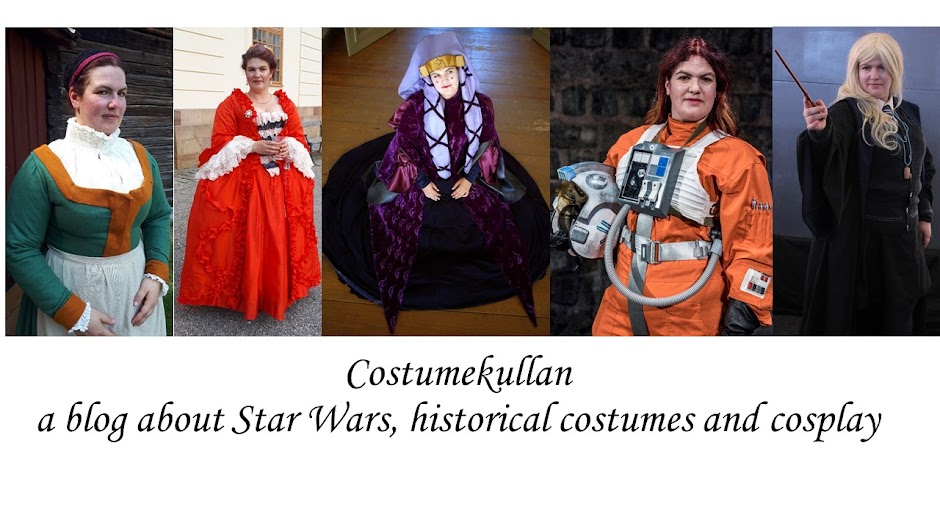This is a summary of the work with my 1520's court gown. It's been a long project. I wrote in my HSM costuming plans for 2016 that I wanted to make this gown, and now it's almost 5 years later. The years really developed my skills as a seamstress, so I'm happy that I waited until now to make it. The work on this project can be found with the tags 1520's or 1520's court gown. I've worked on the project so long that I haven't had a consistent tagging for it.
Anyway the theme for August was Celebration:
Make something for a specific historical celebration, make something generally celebration worthy, make something that celebrates a historical hero, or just make something that celebrates some new skills you’ve learned.
This ticks all the boxes. It is a gown that was made to be something that could have been worn at the coronation of Christian II in Sweden in 1520. The guests definitely thought it was something to celebrate, before the coronation was turned into the Bloodbath of Stockholm. It is also a gown that is based on something that Christina Gyllenstierna could have worn. She is definitely one of my heroes, and she has a wiki article here if you want to read a short summary of her life. It leaves out a lot, especially in her later life, but it's enough to show what a fascinating character she is. Thirdly this project made learn goldwork, so it celebrates those skills. I still have a long way to go until I master it, but it is definitely a new skill for me.
The inspiration for the gown is the figure of Christina Gyllenstierna on the main altar piece in Västerås' Cathedral, Sweden, the only available image that was done in her lifetime. It's from 1516.
Since the cape covers so much of the figure I've also used this altarpiece from 1506 by Lucas Cranach as inspiration, not the least for the headpiece. It's available in high resolution from the digital
Lucas Cranach Archive. The painting dates a bit earlier, to 1506, but it is the only one I've found with a very similar headpiece, and the simple style of the dress, without slashing, wasn't out of fashion in 1520.
I also used the Maria von Habsburg (Mary of Hapsburg as most internet sources say) gown that is dated to 1520 and has been preserved in Hungary. It's not only on display but has detailed
descriptions of the pattern and the constrution published online. I couldn't quite use it straight off though, since I didn't want that open front, from what I can see of the figure there is nothing suggesting that is open in the front.
As underwear I'm using a basic shift, with an attached gold ribbon. This is a temporary solution and I am working on a new, embroidered shift. The next layer is my
mustard kirtle.  |
| The kirtle when worn as an outer gown |
The kirtle makes this a really warm costume, but it is necessary in order to make the skirt stand out from the legs, and not just hang limply.
The main gown consists of a bodice, S-sleeves that are cut off at the middle and tied together and a full circle skirt, that has been pieced to make a full circle. The sleeves are tied together with black velvet ribbons. The fabric is a gold silk velvet from Beckford silk. The whole gown, including the skirt, is interlined in an unbleached linen fabric. This was the best way of making sure that the slippery velvet didn't move too much. The hem has a deep hemguard of wool broadcloth. This also helps the skirt to stand out from the feet and means it's possible to walk in it without having to use your hand to lift the skirt. The guards around the neckline, down the front and the cuffs is made from a reproduction polyester brocade from
Sartor.

As accessories I am using my
rosary of coral and gold beads and my
sweetbag with goldwork. The sweetbag is more similar to purses used in the late 16th century, but I need somewhere to keep my insulin and phone, with my app that monitors my glucose levels.
The embroidered cap has its own tag here. It is made of fine linen, with an interlining of cotton canvas and a lining of heavier linen. The embroidery is mostly japanese gold thread and pearl purl in different sizes and colours. It is covered by a silk gauze veil that has been tied around the head with the ends tucked in under the cap.
I'm also wearing a reproduction of a necklace worn by Catherine of Aragon, dated to the 1520's, from the etsy seller TudorJewels and a 15th century ring from Historiska Fynd.
So just the facts, and this is for the gown only
The Challenge: August - CelebrationMaterial: 9 meters of silk velvet, 9 meters of unbleached linen, 1,5 m wool broacloth, 1m poly brocade
Pattern: My own, with inspiration from the cut of the skirt from Maria von Habsburgs gown
Year: 1516-1520
Notions: 3 m silk ribbons, silk sewing thread, linen sewing thread, silk buttonhole threads, a ball of wool yarn (for the braided lacing cord)
How historically accurate is it? I've tried my best, but I've had to take more modern short cuts, for example with the poly brocade, so I would say 80%
Hours to complete: I've worked on it on and off for 8 months
First worn: A photo session on October 24th
Total cost: $500




















































